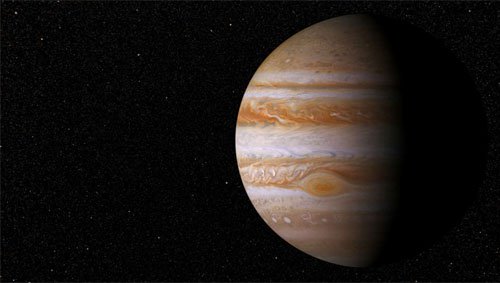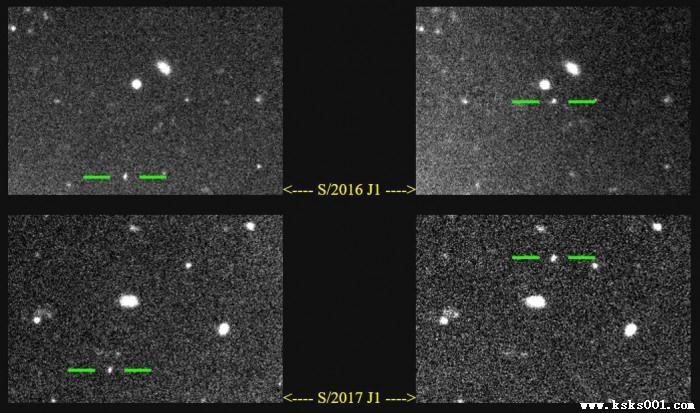2 more moons found around Jupiter
New Jupiter 2 moon has been discovered by scientists, bringing the planet's total Moon to 69 individuals.
- How big is the solar system?
- Did you know: Mars, Venus has rotten egg smell and the Moon smells of gunpowder

Artwork of Jupiter (Photo: iflscience).
New Moon
2 Jupiter's new moons are named S / 2016 J1 and S / 2017 respectively J1. According to scientists from the Carnegie Institute of Science, those who discovered these two new moons, they are placed according to the date of detection in the sky. Jupiter's "J" means Jupiter and the "S" in satellite means satellite.
Both of these new Moon fly around Jupiter at a distance of 21 million km, 24 million km and have diameters of about 1 km and 1.2 km respectively.
In addition, S / 2016 J1 needs 1.65 years and S / 2017 J1 needs 2.01 years to complete 1 rotation.
Especially, S / 2016 J1 and S / 2017 J1 has a high inclination of about 140 to 149 degrees (compared to the parent star's plane). According to astronomers observations, the trajectories of these two moons are also very strange, they fly fast and very close to the planet but sometimes fly slowly and far away.
Jupiter also has many moons orbiting it that we have not yet discovered
For the first time, scientists observed these moons in the sky respectively in March 2016 and March 2017. At that time, they were looking for signs of the 9th planet outside the Solar System with the Subaru telescope in Mauna Kea, Hawaii, when they accidentally saw images of these two planets appearing near Jupiter.
Jupiter is the largest planet of the Solar System and there are 53 officially named Moon and more than a dozen Moon waiting to be recognized by the International Astronomical Association. According to astronomers, there is a possibility that there are many Moon like this nearby.

The new 2 Moon images were captured by the telescope when flying over Jupiter.(Photo: iflscience).
With this new discovery, Jupiter becomes the most moon-shaped planet (69 individuals) and is the oldest planet in the Solar System.
You should read it
- Hot Jupiter is being torn apart by its host star
- The distance from Earth to Jupiter - what is the largest planet of the solar system?
- Admire the rare moment Venus and Jupiter 'meet' each other in the sky
- Did you know: Mars, Venus has rotten egg smell and the Moon smells of gunpowder
- Early in the morning, Venus and Jupiter will meet in the sky, don't miss this magical, rare moment!
- The most spectacular cosmic photos 2017
- For the first time, toxic gas has been discovered that confuses astronomers
- What is super moon? Vietnam will welcome super moon at any time in 2018?
May be interested
- A 30-ton meteorite was discovered hitting Earth 4,000 years ago
 scientists have discovered a giant meteorite weighing 30 tons has crashed into earth in a meteor shower 4,000 years ago in argentina. this is the second largest meteorite ever found in history.
scientists have discovered a giant meteorite weighing 30 tons has crashed into earth in a meteor shower 4,000 years ago in argentina. this is the second largest meteorite ever found in history. - What is the FOUND,000 folder and the file FILE0000.CHK on Windows?
 on some partitions you may see a folder called found,000 and a file in that directory with the extension .chk. so what is the found.000 folder and the file file0000.chk? why is this file and folder on windows? please refer to the following article of network administrator.
on some partitions you may see a folder called found,000 and a file in that directory with the extension .chk. so what is the found.000 folder and the file file0000.chk? why is this file and folder on windows? please refer to the following article of network administrator. - What is lost + found folder on Linux and macOS?
 on linux, users use the fsck (file system check) command to check for corrupted system files. fsck can find corrupted files on the file system. if any files are found to be corrupted, fsck will remove the corrupted data from the file system and move to the lost + found directory.
on linux, users use the fsck (file system check) command to check for corrupted system files. fsck can find corrupted files on the file system. if any files are found to be corrupted, fsck will remove the corrupted data from the file system and move to the lost + found directory. - Ways to fix 'Word Found Unreadable Content' error
 are you getting the 'word found unreadable content' error? here are some easy and quick steps to fix 'word found unreadable content'.
are you getting the 'word found unreadable content' error? here are some easy and quick steps to fix 'word found unreadable content'. - How to fix 'An operating system not found' error on Windows 10 and Windows 8.1
 error an operating system was not found is one of the common ones that usually happens on windows 10 or windows 8.1. this error comes out after the user upgrades windows (from windows 8.1 to windows 10), updates the bios, .... if the screen of your windows 10 or windows 8.1 computer displays the message an operating system wasn ' t tìm thấy. hãy thử gỡ bỏ nào nào mà không chứa một hệ thống hành động. press ctrl + alt + del to restart, follow the steps below to fix the error.
error an operating system was not found is one of the common ones that usually happens on windows 10 or windows 8.1. this error comes out after the user upgrades windows (from windows 8.1 to windows 10), updates the bios, .... if the screen of your windows 10 or windows 8.1 computer displays the message an operating system wasn ' t tìm thấy. hãy thử gỡ bỏ nào nào mà không chứa một hệ thống hành động. press ctrl + alt + del to restart, follow the steps below to fix the error. - How to fix Boot device not found error
 boot device not found error. when we reinstall windows and first start the computer, you will often encounter the error boot device not found, in fact this is a relatively common error and many people encounter.
boot device not found error. when we reinstall windows and first start the computer, you will often encounter the error boot device not found, in fact this is a relatively common error and many people encounter. - How to fix 'apt-get: command not found' error in Linux Terminal
 if you want to install software on a debian-based linux distribution, apt-get is a reliable terminal command. however, sometimes you may get stuck with 'command not found' error as response.
if you want to install software on a debian-based linux distribution, apt-get is a reliable terminal command. however, sometimes you may get stuck with 'command not found' error as response. - 6 ways to fix the error 'PowerPoint found a problem with the content'
 have you ever encountered the powerpoint found a problem with the content error when opening a .ppt or .pptx file? if restarting your device didn't help, try these tips to get you back to work in no time.
have you ever encountered the powerpoint found a problem with the content error when opening a .ppt or .pptx file? if restarting your device didn't help, try these tips to get you back to work in no time. - How to fix Msstdfmt.dll Not Found error
 the msstdfmt.dll error is caused by situations that lead to the deletion or corruption of the msstdfmt dll file. in some cases, the msstdfmt.dll error can indicate a registry problem, a virus or malware problem, or even a hardware failure.
the msstdfmt.dll error is caused by situations that lead to the deletion or corruption of the msstdfmt dll file. in some cases, the msstdfmt.dll error can indicate a registry problem, a virus or malware problem, or even a hardware failure. - Uranus's 4 icy moons can exist liquid water oceans
 water is considered one of the essential elements constituting life on earth, and is also the most studied chemical compound in the universe by humans.
water is considered one of the essential elements constituting life on earth, and is also the most studied chemical compound in the universe by humans.










 Video: Cassini spacecraft successfully performs the journey around Saturn
Video: Cassini spacecraft successfully performs the journey around Saturn black hole, white hole, deep hole
black hole, white hole, deep hole How big is the solar system?
How big is the solar system? Detecting the tremors of the 'twin brothers' of the solar system, the key to deciphering early life
Detecting the tremors of the 'twin brothers' of the solar system, the key to deciphering early life For the first time in history, Cassini obtained strange sounds from Saturn
For the first time in history, Cassini obtained strange sounds from Saturn Startled with the hypotheses about the number of universes co-existed by scientists
Startled with the hypotheses about the number of universes co-existed by scientists